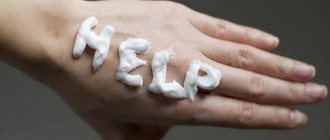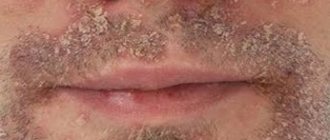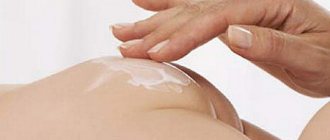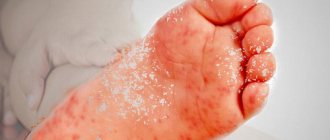Are cracks in a child’s fingers dangerous?
Almost all children at least once in their lives experience dry fingers or palms and the appearance of minor injuries on the skin of their hands. In most cases, such microtraumas are not dangerous and heal on their own. However, if they do not go away for a long time, are accompanied by pain and itching, this problem cannot be ignored. Cracking of the skin on the hands may indicate the presence of serious diseases of the internal organs and body systems. Therefore, if you notice that your child’s fingertips, knuckles and palms are cracking, be sure to consult a doctor.
Briefly about diagnostics
A visual examination will not be enough; experts strongly recommend scraping the damaged area.
In addition, you will need:
- take a blood test to make sure there is no infectious pathology;
- take a stool test to determine the presence of helminthiasis;
- be examined by several specialized specialists.
Most often, a consultation with a gastroenterologist or endocrinologist is necessary to make a diagnosis. A visit to an allergist, dermatologist and neurologist may be required to determine why the skin on your child’s toes is peeling.
Do not miss
- Do not miss
It's not just about care: 7 health problems that cause the skin on your face to peel
Cracks on a child's fingers: causes and treatment
Any violation of the integrity of the skin that appears in children causes concern among parents. Therefore, as soon as mothers and fathers notice the appearance of this problem, they ask the question: “Why do the child’s fingers crack?” Only a doctor can answer this question competently, so first of all it is recommended to consult a pediatrician or dermatologist.
The occurrence of such damage can be caused by external and internal preconditions.
External factors:
- Mechanical impact, friction. If there is constant pressure or friction on a child's palms and fingers, the integrity of the skin may be compromised.
- Temperature effect. If a child has cracked fingers in winter after spending a long time outside without gloves, this may be the result of exposure to low temperatures.
- Insufficient air humidity. With the start of the heating season, many people complain of increased dry skin. Therefore, if the air in the room where the child is is too dry, this can lead to the formation of microcracks in the hands.
- Reaction to contact with soap, household chemicals, chlorinated water, etc. Aggressive components of hygiene products and chlorinated tap water can dry out the skin. As a result, it cracks, causing pain and discomfort to the child.
Internal factors that cause cracks in a child’s hands include the following:
- Dermatological diseases. Dry eczema, psoriasis, contact and allergic dermatitis - all these diseases can manifest as dry and cracking skin on the hands.
- Fungal skin lesions. Fungi are often localized on the fingers and toes. If, in addition to the formation of skin cracks on the fingers, the lesion also affects the nails, this may be a sign of onychomycosis, a fungal disease caused by the fungi Trichophyton rubrum.
- Infectious diseases. One of the signs of scarlet fever is peeling of the skin on the palms and soles with the formation of cracks on it.
- Hypovitaminosis. A lack of certain vitamins (A, B1, C, P) in the body causes the skin to dry, peel and crack. In some cases (for example, with vitamin PP hypovitaminosis), the skin may not only crack, but also peel off in layers.
- Anemia. Metabolic disorders characteristic of anemia (anemia) often lead to impaired oxygen supply to the skin. As a result, the child's fingertips crack.
- Hypothyroidism. In most cases, hypothyroidism occurs not in children, but in adults, but sometimes it can develop in childhood. Its symptoms include, among other things, dry skin on the heels and palms, cracking, and brittle nails.
- Diabetes. Diabetes mellitus is often accompanied by skin lesions on the palms and heels: it becomes dry, rough, its turgor decreases, and deep cracks appear.
- Scleroderma. When a child develops systemic scleroderma (an autoimmune connective tissue disorder), the skin on the fingers may become thick, dry, and cracking.
- Raynaud's disease. It is a phenomenon of a three-phase change in the color of the skin of the fingers and toes, and in some cases also the tip of the nose, lips, tip of the tongue, and auricle. At the beginning of the attack, whitening of the skin appears, accompanied by coldness and a feeling of numbness. This phase is replaced by a phase of cyanosis - blue discoloration of the skin. At the end of the attack, redness appears with a feeling of heat, “crawling goosebumps,” and pain. The disease mainly affects adults, but in rare cases it can also be diagnosed in children. The disease is manifested by excessive dryness of the skin on the hands and feet, the appearance of hangnails near the nails, and the formation of ulcers and cracks.
- Reaction to stress. Severe emotional shock can lead to disruption of the hydrolipid balance of the skin, its dryness and cracking.
Treatment of cracks on the fingers of a child should be carried out under the supervision of a specialist. The doctor will prescribe appropriate therapy depending on the root cause of the problem. Usually, to speed up recovery, it is recommended to use moisturizing and nourishing creams and ointments that normalize the hydrolipid balance of the skin, eliminating dryness and flaking. If the problem is caused by a fungal infection, antimycotics (antifungal drugs for external use) are prescribed. If skin cracking is accompanied by severe itching, antihistamines may be recommended. Also, to achieve a positive result, it is important to eat a balanced diet and, if necessary, take vitamin and mineral complexes. It is important to protect the skin of your hands from aggressive substances contained in household chemicals and hygiene products, as well as limit contact with chlorinated water.
You can supplement the treatment prescribed by your doctor with the use of La-Cri products. To combat this problem, La Cree cream for dry skin is well suited. The product contains natural vegetable oils - jojoba, shea and wheat germ. They improve the condition of the hydrolipid mantle of the epidermis, fight dryness and provide the necessary nutrition to the skin. Beeswax is known for its nourishing and emollient properties. In addition, it has a restorative and anti-inflammatory effect on damaged skin. Natural extracts of licorice and string reduce itching, fight flaking and redness of the skin, and have an anti-inflammatory effect.
What complications may arise
Exfoliative keratolysis does not cause functional changes in the baby’s systems and organs. Most often, this unpleasant phenomenon is a symptom of a hidden illness, a pathological process. The danger of increased desquamation is associated with a violation of the integrity of the skin and the addition of a bacterial or fungal infection.
If an infectious infection occurs, then inflamed ulcers and blisters appear on the back of the palms. At the slightest injury, they open, itch, and provoke the appearance of new papules and the formation of yellow crusts.
Experts' opinion
According to the results of clinical studies conducted by the Union of Pediatricians of Russia, it was proven that when using a complex of TM LA-KRI products, the level of skin moisture decreased by 4% in comparison, and in the group that used placebo, the level of moisture decreased by 9%.
The conducted clinical study proves the high efficiency, safety and tolerability of products for daily skin care of children with mild and moderate forms of atopic dermatitis and during remission, accompanied by a decrease in the quality of life of patients. As a result of therapy, a decrease in the activity of the inflammatory process, a decrease in dryness, itching and flaking was noted.
It has been proven that La Cree cream for dry skin:
- eliminates dryness and flaking;
- retains the skin's own moisture;
- protects skin from wind and cold.
What to do
A dermatologist can correctly diagnose the reason why the skin of your hands is peeling, so if you have such a symptom, it is better to immediately contact a dermatologist. Until this point, you can try to improve the condition or at least alleviate it. The first thing you need to do is start taking care of your skin. After washing, they need to be dried thoroughly. Twice a day, the skin should be lubricated with a nourishing cream containing chamomile, glycerin or aloe. The following will help improve your condition:
- Baths. A very effective recipe is 1 tablespoon per 1 liter of water. Leave your hands in this composition for about a quarter of an hour, after which they are blotted with a napkin and lubricated with cream.
- Masks. Honey ones are especially useful. Honey should simply be applied to the skin. After half an hour, it is washed thoroughly.
- Lotion. Rub your hands with a piece of cucumber, then lubricate them with a mixture of glycerin cream and lemon juice.
- How to smoke mackerel in a hot smoker correctly. Hot smoked mackerel recipes
- Laser tattoo removal
- Diet for hypertension - table No. 10 with a menu for every day. Proper nutrition and products for high blood pressure
A child has cracked skin on his fingers: is this dangerous?
If the cracks are small and shallow, they are not dangerous in themselves. However, they violate one of the main functions of the skin - protective. Therefore, if an infection gets into them, an inflammatory process may develop, followed by suppuration. This means that even the smallest areas of chapped skin cannot be left unattended. It is necessary to find out the reason for their appearance and begin appropriate treatment.
In addition to the possible penetration of infection, cracks in a child’s hands are dangerous for another reason. They hurt and cause discomfort; it may be difficult for the baby to bend his fingers and touch anything. They can also interfere with a child’s social adaptation, causing him psychological discomfort when communicating with peers, at school or in kindergarten.
Sources:
- Smirnova G.I. Atopic dermatitis and skin infections in children, Russian pediatric journal, 2014
- E.N. Saverskaya, Diaper dermatitis: answers to questions from pediatricians and parents in the light of current global trends, Medical Council magazine, 2019
- I.I. Ryumina, V.V. Zubkov, Newborn skin care, Healthy Child magazine, 2017
Photos of eczema
Photo album on the diseaseHow to make an appointment with a dermatologist
You can make an appointment with a dermatologist at the pediatric department of JSC “Medicine” (academician Roitberg’s clinic) using the form on the main page of the site. It is necessary to enter feedback information in order to agree on a convenient time and date for a visit with the child.
If it is necessary to make an accurate diagnosis, the doctor can additionally refer you for examination to other specialized specialists: an allergist, an immunologist, etc. Contact reception number for questions and appointments with doctors. The clinic has a convenient location in the Central Administrative District near the Mayakovskaya metro station at the address: Moscow, 2nd Tverskoy-Yamskaya lane, building 10. Other stations are within walking distance: Belorusskaya, Chekhovskaya, Novoslobodskaya, Tverskaya " Qualified doctors with extensive experience treat young patients with care and attention.
Take care of the health of your children together with JSC “Medicine” (clinic of academician Roitberg).
Prevention
Regular preventive measures can help prevent skin problems. It consists of good hand care, which includes:
- Dry your hands thoroughly after washing;
- refusal of antibacterial soap in favor of a soft gel for sensitive hand skin;
- drink up to 2 liters of fluid daily to prevent dehydration;
- use sunscreen in summer;
- in cold weather, always wear mittens or gloves;
- maintain proper nutrition so that the diet is rich in vitamins;
- use rubber gloves when doing housework;
- use hypoallergenic cosmetics;
- Lubricate your skin with moisturizing creams daily.
Etiology
Violations in the condition of one or several nail plates in a child can be caused by various reasons:
- congenital anomalies;
- hereditary predisposition;
- chemical, biological, physical and mechanical injuries to the nails: the habit of sucking fingers or biting nails, external exposure to chemicals or high temperatures, improperly performed manicure, fungal infections, uncomfortable shoes, etc.;
- dermatological pathologies contributing to nail damage: eczema, psoriasis, alopecia, etc.;
- pathologies of the endocrine system: diabetes mellitus, thyroid dysfunction, etc.;
- lack of vitamins and minerals;
- general intoxication of the body, taking certain aggressive medications;
- stress;
- suffered serious illnesses, chronic pathologies, infections, mental disorders, neoplasms, etc.
Sometimes the development of dystrophy is provoked not by one, but by several factors at once; their determination is an important task for a podiatrist. After identifying the root causes, the specialist can eliminate the effect of negative factors and develop the most effective treatment plan with corrective manipulations to improve the appearance of the nail plates.









